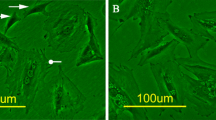Summary
Seminiferous tubules from human testes were mechanically isolated, the cut edges were sealed, and the tubules were cultured in medium free of fetal calf serum (FCS). Degeneration of germ cells occurred during the culture period and was paralleled by a disruption of the seminiferous epithelium, a disturbance in morphology and function of Sertoli cells, and a thickening of the lamina propria. However, when tubules were cultured for 5 days in the presence of FCS, degeneration of the spermatogenic tissue was reduced. FCS increased the mitotic activity of germ cells, but did not maintain normal morphology and function of Sertoli cells and cellular elements of the lamina propria. The thickening of the tubular wall concurred with a change in phenotype of lamina-propria cells from myoid to fibroblastic. Addition of nerve growth factor (NGF) to the culture medium (i) maintained the myoid phenotype of lamina-propria cells, (ii) prevented thickening of the tubular wall, and (iii) stabilized Sertoli cell morphology and function. The effects of NGF appeared to depend on the trophic effects of FCS, since NGF alone had no influence on the maintenance of a regular morphology of the spermatogenic epithelium. The present results indicate a decisive role for NGF in stabilizing specific functions of seminiferous tubules.
Similar content being viewed by others
References
Ayer-LeLievre C, Olson L, Ebendal T, Hallböök F, Persson H (1988) Nerve growth factor mRNA and protein in the testis and epididymis of mouse and rat. Proc Natl Acad Sci USA 85:2628–2632
Chowdhury AK, Steinberger E (1977) In vitro 3H-thymidine labeling pattern and topographic distribution of spermatogonia in human seminiferous tubules. In: Troen P, Nankin HR (eds) The testis in normal and infertile men. Raven Press, New York, pp 69–83
Chowdhury AK, Steinberger A, Steinberger E (1975) A quantitative study of spermatogonial population in organ culture of human testis. Andrologia 7:297–307
Djakiew D, Dym M (1988) Pachytene spermatocyte proteins influence Sertoli cell function. Biol Reprod 39:1193–1205
Dym M, Fawcett DW (1970) The blood testis barrier in the rat and the physiological compartmentation of the seminiferous epithelium. Biol Reprod 3:308–326
Gold B, Stern L, Bradley FM, Hecht N (1983) Gene expression during mammalian spermatogenesis. II. Evidence for stage specific differentiation in mRNA populations. J Exp Zool 225:123–134
Hadley MA, Byers SW, Suarez-Quian CA, Kleinman HK, Dym M (1985) Extracellular matrix regulates Sertoli cell differentiation, testicular cord formation, and germ cell development in vitro. J Cell Biol 101:1511–1522
Hecht NB, Kleene KC, Distel RJ, Silver LM (1984) The differential expression of the actins and tubulins during spermatogenesis in the mouse. Exp Cell Res 153:275–280
Holstein AF (1989) Morphological evidence for the involution of spermatogenesis. In: Holstein AF, Voigt KD, Grässlin D (eds) Reproductive Biology and Medicine. Diesbach, Berlin, pp 66–77
Holstein AF, Roosen-Runge EC (1981) Atlas of human spermatogenesis. Grosse, Berlin
Holstein AF, Roosen-Runge EC, Schirren C (1988) Illustrated pathology of human spermatogenesis. Grosse, Berlin
Ireland ME, Welsh MJ (1987) Germ cell stimulation of Sertoli cell protein phosphorylation. Endocrinology 20:1317–1326
Levi-Montalcini R, Angeletti PU (1968) Nerve growth factor. Physiol Rev 48:534–569
Millette CF, Scott BK (1984) Identification of spermatogenic cell plasma membrane glycoproteins by two-dimensional electrophoresis and lectin blotting. J Cell Sci 65:233–248
Olson L, Ayer-LeLievre C, Ebendahl T, Steiger A (1987) Nerve growth factor-like immunoreactivities in rodent salivary glands and testis. Cell Tissue Res 248:275–286
Parvinen M, Wright WW, Phillips DM, Mather JP, Musto NA, Bardin CW (1983) Spermatogenesis in vitro: completion of meiosis and early spermiogenesis. Endocrinology 112:1150–1152
Russell LD, Peterson RN (1985) Sertoli cell junctions: morphological and functional correlates. Int Rev Cytol 94:177–211
Seidl K, Holstein AF (1990) Evidence for the presence of nerve growth factor (NGF) and NGF receptors in human testis. Cell Tissue Res 261:549–554
Skinner MK, Fritz IB (1985) Testicular peritubular cells secrete a protein under androgen control that modulates Sertoli cell functions. Proc Natl Acad Sci USA 82:114–118
Skinner MK, Moses HL (1989) Transforming growth factor β gene expression and action in the seminiferous tubule: Peritubular cell-Sertoli cell interaction. Mol Endo 3:625–634
Skinner MK, Fetterolf PM, Anthony C (1988) Purification of a paracrine factor, P-Mod-S, produced by testicular peritubular cells that modulates Sertoli cell function. J Biol Chem 236:2884–2890
Steinberger E, Steinberger A, Perloff WH (1964) Studies on growth in organ culture of testicular tissue from rats of various ages. Anat Rec 148:581–589
Thoenen H, Barde Y-A (1980) Physiology of nerve growth factor. Physiol Rev 60:1284–1335
Toppari J, Mali P, Eerola E (1986) Rat spermatogenesis in vitro traced by quantitative flow cytometry. J Histochem Cytochem 34:1029–1035
Toebosch AMW, Brussee R, Verkerk A, Grootegoed JA (1989) Quantitative evaluation of the maintenance and development of spermatocytes and round spermatids in cultured tubule fragments from immature rat testis. Int J Androl 12:360–374
Welsh MJ, Ireland ME, Treisman GJ (1985) Stimulation of rat Sertoli cell adenylate cyclase by germ cells in vitro. Biol Reprod 33:1050–1056
Author information
Authors and Affiliations
Rights and permissions
About this article
Cite this article
Seidl, K., Holstein, AF. Organ culture of human seminiferous tubules: A useful tool to study the role of nerve growth factor in the testis. Cell Tissue Res 261, 539–547 (1990). https://doi.org/10.1007/BF00313533
Accepted:
Issue Date:
DOI: https://doi.org/10.1007/BF00313533




